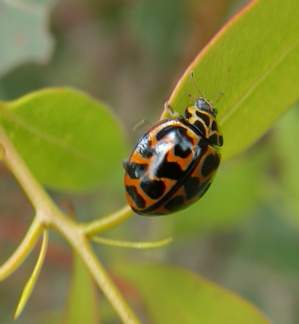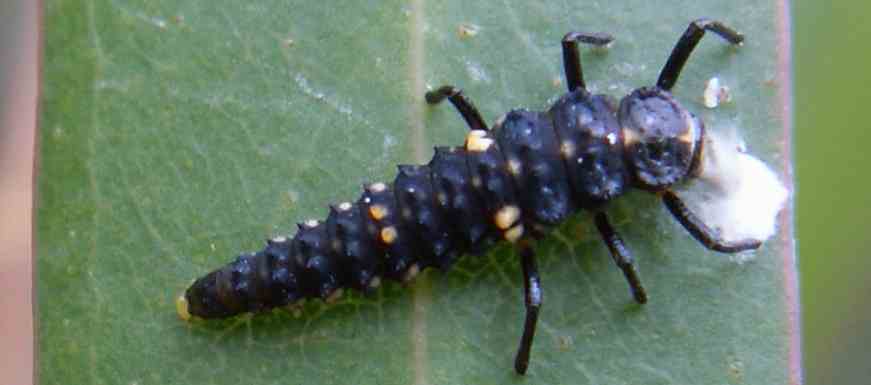PESTS AND DISEASES OF FORESTRY IN NEW ZEALAND
Report on field trip to the Marlborough Sounds 17-19 October 2005
Kaiuma Bay


Most Cleobora ladybirds were collected here, and were relatively abundant on both the eucalypts and blackwoods (Acacia melanoxylon) at this site. Blackwoods and eucalypts were mostly large trees, which limited collections from foliage within reach of the ground. Some trees became favoured sites for collection with abundant numbers of Cleobora, while other trees had none. Psyllids appeared to be in low numbers in all life stages. Cleobora larvae were found as a range of instars but were not abundant. About one third of the Cleobora adults were found as mating pairs. A young 4-5m Ash Eucalypt tree (possibly E.fastigata or E.delegatensis) was regularly visited by Cleobora (we collected two every day on average) despite this species not harbouring psyllids. Paropsis charybdis (Tortoise Beetle) damage was noted on this tree, at low levels, but neither Paropsis eggs nor larvae appeared to be present. Cleobora were found in comparable abundance on Eucalyptus macarthurii and Blackwoods. E. macarthurii is recognised as highly susceptible to Paropsis browsing, and had moderate levels of damage. These are mature trees with foliage down to near ground level. Adult Cleobora were observed both in the shoots, presumably searching for psyllids (quite common on these trees) and also searching over the mature leaf faces, presumably for Paropsis eggs. Both Cleobora larvae and Paropsis larvae were present as a range of instars, but no egg masses were found for either. Paropsis larvae were more abundant than Cleobora larvae. However it was very inspiring to find Cleobora in reasonable numbers in the Eucalyptus trees. Harmonia conformis (large spotted ladybird) were also present at this site, but only on blackwoods, and in much lower numbers than the Cleobora. No steelblue ladybirds (Halmus chalybeus) were found.
Geographical distribution
Cleobora is well established at Maori Bay and Kaiumu bay in the Marlborough Sounds. We did not find it in Nelson, nor the Rai Valley and Canvastown. We found Cleobora at Havelock occasionally in Blackwood trees and Ake-ake (Dodonaea viscosa). Steelblue ladybirds were very common in some Blackwood trees at Havelock. Cleobora was absent in young Eucalyptus nitens in Havelock (3-4m high) infested with the Bluegum Psyllid, Ctenarytaina eucalypti. Cleoborawas present at Moenui (Paul Millens) in a mixed stand of 20 year old blackwoods and eucalypts, but was in low numbers on the blackwood foliage that was visible from the ground. Psyllids were notably absent from these trees, and form was good. Between Havelock and Picton on Queen Charlotte Drive wild Ake-ake was very common. We did not check these trees, but stoppped at the Grove, and could not find Cleobora in cultivated Ake-ake, despite psyllids being present. On Queen Charlotte Drive near Picton we found a stand of Blackwoods with adjacent E.nitens and E.leucoxylon. Cleobora was not found, and psyllids appeared to be absent or in very low numbers. However two Cleobora adults were found on an adjacent Ake-ake tree. Paropsis larvae were common on the E. leucoxlyon, but psyllids were not present. We found Cleobora larvae in Ake-ake trees at Picton, but not in large numbers, despite psyllids being common. Cleobora was absent in silver wattle (Acacia dealbata) infested with psyllids at Picton Cemetary. Silver wattle is common around Picton. Cleobora was present in a mixed blackwood and E.obliqua stand owned by the Marlborough District Council south of Picton. Paropsis damage to the E.obliqua was evident. No Cleobora was found at Blenheim in blackwood and Acacia longifolia.
A total of 240 Cleobora adults were collected on the 17th and 19th October 2005. Many thanks Paul Millen for a guided tour of the area.

 Farm Forestry New Zealand
Farm Forestry New Zealand

